Auctions
Asian Bidding Rouses Sotheby’s $270.7 Million Contemporary Sale, With the Same Buyer Snapping Up Two of the Priciest Paintings
Still, fireworks were muted—the sale's total was down more than 25 percent from the equivalent sale in 2018.
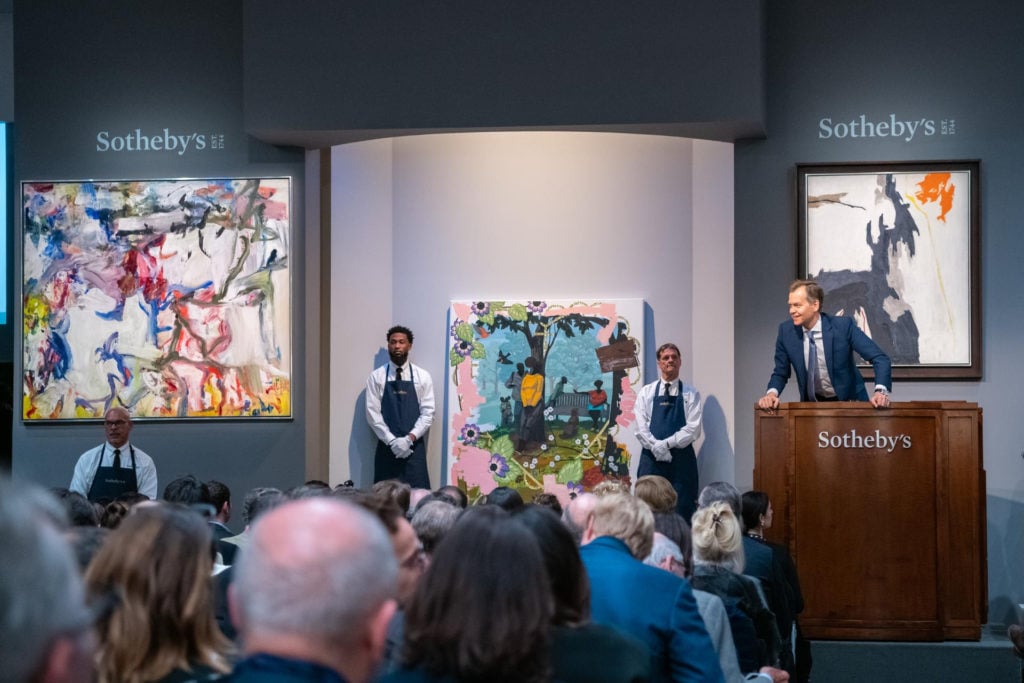
Still, fireworks were muted—the sale's total was down more than 25 percent from the equivalent sale in 2018.

Nate Freeman

A single Asian private collector on the phone with Sotheby’s Hong Kong-based contemporary art head scooped up two of the top three lots at the house’s postwar and contemporary art evening sale on Thursday night, spending a total of $54.4 million.
That shopping spree—which accounted for 20 percent of the evening’s total—was part of a blitz of phone bidding through Asia-based specialists that lifted the house to a $230 million sale, above the low estimate of $205.7 million. With fees, the evening generated a total of $270.7 million. (Unless otherwise noted, final prices include the buyer’s premium; presale estimates do not.)
While the total was down more than 25 percent from the equivalent sale a year ago, which brought in $362.6 million, the Sotheby’s auction ended this week’s run of bellwether evening sales on a relatively secure note, averting disaster during a run of auctions that lacked the nine-figure lots and record-breaking estates of years past.

Willem de Kooning, Untitled XXII (1977). Photo courtesy of Sotheby’s.
The sell-through rate, meanwhile, was a solid 92 percent by lot—even better than the 89 percent at the decent auction at Christie’s on Wednesday night. In other words, even if the price points are lower than in years past, the teams on both sides of the duopoly know how to connect consignors and buyers in a way that appears effective and efficient.
We may not be in the boom times, but at least we have consistency.
At the top end, bidding through the house’s Asian clients dominated. The bidder on the phone with Yuki Terase, Sotheby’s contemporary art head in Asia, bought the night’s biggest lot, Willem de Kooning’s Untitled XXII (1977), for $30.1 million with fees. Her competition on the lot—which sold comfortably within its presale estimate of $25 million to $35 million—was Patti Wong, the house’s Asia chairman.
And just two lots earlier, Terase’s caller with the same paddle number—lucky L0070—bought Clyfford Still’s PH-399 (1946) for $24.3 million, well above the $18 million high estimate. It was a hard-won victory after more than 15 minutes of bidding, with Terase beating out contemporary art head Grégoire Billault after what seemed like an eternity going back and forth.
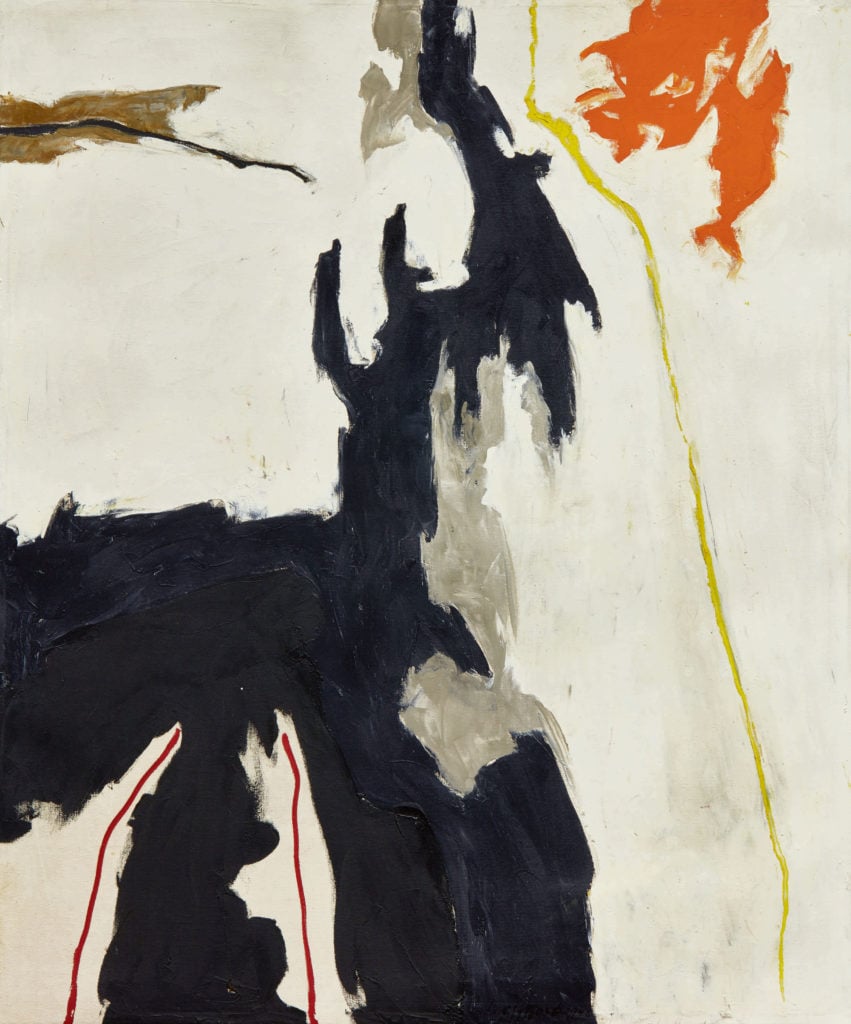
Clyfford Still, PH-399 (1946). Photo courtesy of Sotheby’s.
It was rumored that the collector on the phone with Terase was the Japanese billionaire Yusaku Maezawa, who in 2017 bid through her to buy a large Basquiat skull painting for $110.5 million, smashing the artist’s auction record. Though Maezawa has been deaccessioning work more than buying in the past year, this week it was announced that 50.1 percent of his online fashion retail company, ZOZO, would be sold to Yahoo Japan for $3.7 billion—giving Maezawa an influx of spending money.
Calls and emails to Maezawa’s private foundation in Tokyo were not returned. It’s also possible that Terase was bidding on behalf of a client in Hong Kong, where she is based.
The night’s second biggest lot was Mark Rothko’s Blue Over Red (1953) and it, too, sold to an Asian bidder—though this time the buyer was on the phone with Wong (and using a different paddle number, alas). The painting hammered at $23 million after just a single bid in a room, bringing it to $26.5 million with fees (and eking just over the low estimate of $25 million). Wayne Thiebaud’s Encased Cakes (2010–11) also went to an Asian private collector, setting a new record for the artist with a price of $8.5 million.
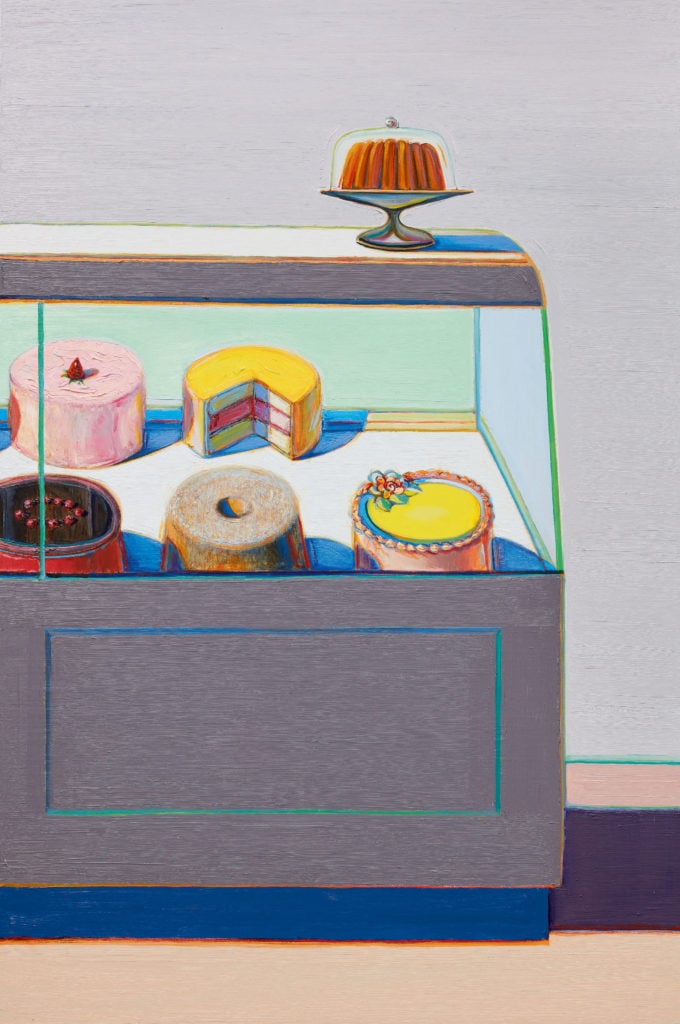
Wayne Thiebaud, Encased Cakes (2011). Photo courtesy of Sotheby’s.
“We have an amazing Asian team—you saw the results in Hong Kong, with the Nara price,” Billault said in the press conference after the sale, referring to the Yoshitomo Nara that sold for $25.9 million at Sotheby’s Hong Kong in October. “They are coming to every single sale in New York or in London and so we weren’t really surprised.”
It’s been a year and a half since the May 2018 sale where Sotheby’s set an historic new record for Kerry James Marshall and had a bonanza of a result for five paintings by black artists to benefit the Studio Museum in Harlem. And, as evening sale head David Galperin argued during the post-sale press conference, Sotheby’s is still the place where new records for black artists season after season.
On Thursday, the highly watched first lot was a work on paper by Charles White, Ye Shall Inherit the Earth (1953), and it set a record not just for the artist in that medium, but for any medium—beating out, remarkably, the full painting that sold last night at Christie’s. It sold for $1.8 million to Lisa Dennison, the chairman of the Americas at Sotheby’s, after a three-way bidding war.
Another record was set for Norman Lewis when the rich blue Ritual (1962) hammered for $2.3 million, or $2.8 million with fees, well above the late American painter’s previous record of $956,000.
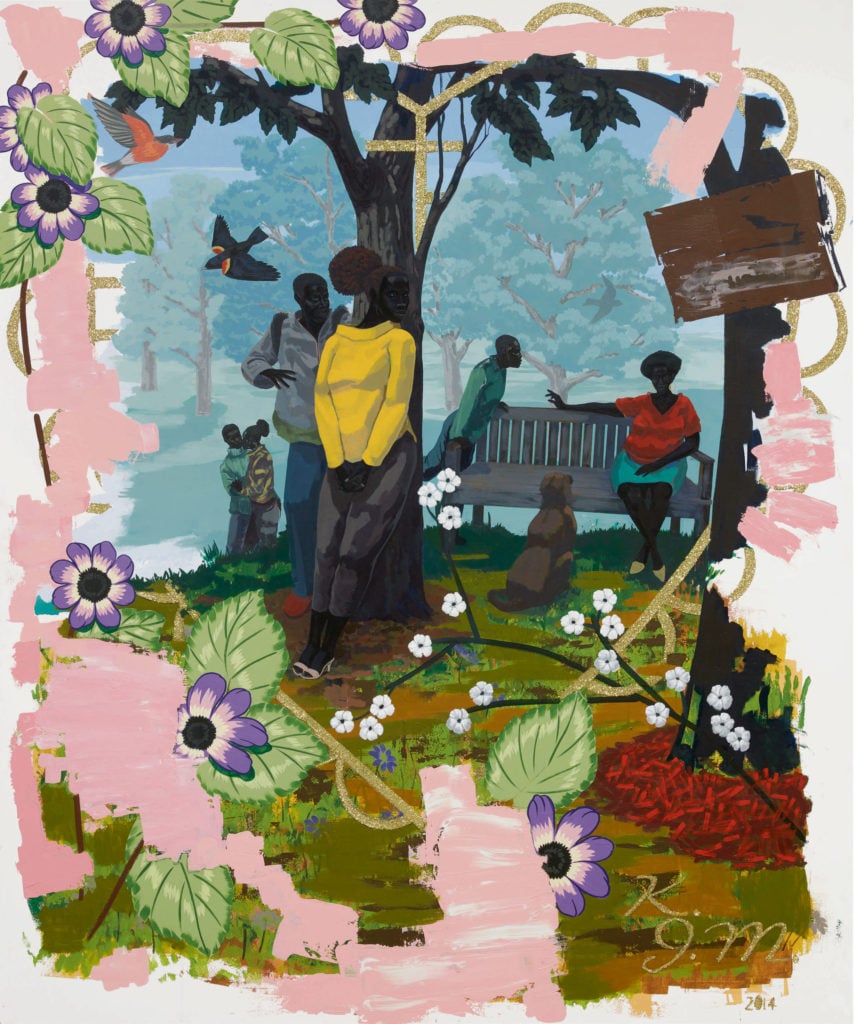
Kerry James Marshall, Vignette 19 (2014). Photo courtesy of Sotheby’s.
And while it wasn’t a record, the fourth-priciest lot of the evening was Kerry James Marshall’s Vignette 19, which hammered at $16 million, more than double the high estimate of $7.5 million. The with-fees total was $18.5 million, coming close to toppling the astounding $21.1 million record for Marshall’s Past Times (1997), which was bought by the rapper and entrepreneur P. Diddy. This work sold to a client on the phone with Cassandra Hatton (whose focus, intriguingly, is on rare books rather than contemporary art, suggesting an unfamiliar player could be entering the Marshall market).
But there were also signs that the market was compressing, and collectors were being way more careful about what they wanted to buy. Hit hardest by the shaky market may have been fashion designer Marc Jacobs, who consigned a number of works to Sotheby’s across its November sales, only to see the first few on offer sputter on the block.
Despite the record-breaking performance for Ed Ruscha last night at Christie’s, two of the artist’s works, both from the designer’s holdings, failed to sell on their first attempt. First, there were no bids for She Gets Angry At Him (1974), estimated to sell for between $2 million and $3 million. (The work last sold for $2.1 million in 2014, suggesting this particular angry picture may not have held its value.)
Then there was Broken Glass (1968), which also got no bids—but then was offered again at the end of the sale, and nabbed a single bid of $1.4 million from contemporary specialist Bame Fierro March, averting an embarrassment for the sale. (Both works, like many consigned by Jacobs, were guaranteed by the house, meaning Sotheby’s is on the hook unless it can find a buyer to meet the reserve in a private sale.)
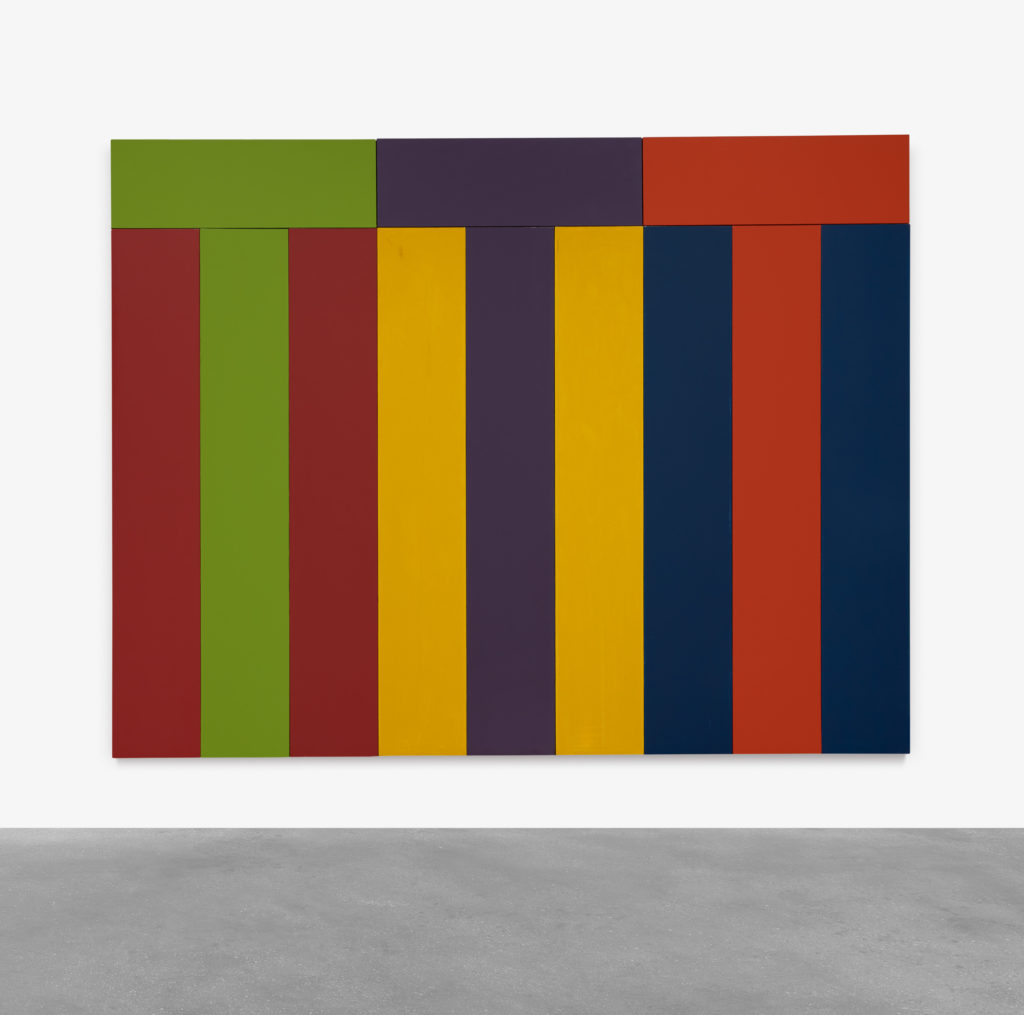
Brice Marden, Number Two (1983–4). Photo courtesy of Sotheby’s.
And while there was a new record for American painter Brice Marden, it totally underwhelmed—especially considering the momentum generated by a sold-out show of new works on view at Gagosian’s Madison Avenue flagship just a few blocks away. A single $9.6 million bid on Number Two (1983–4) from fine art division chairman Amy Cappellazzo, presumably by the guarantor, set a new record for the artist. The $10.9 million with-fees figure edged out the previous record by the slimmest of margins: $3,600, pennies in the context of an evening sale. And as the sale wound down, with collectors streaming out of the back door, works by Hans Hofmann, Robert Motherwell, and a David Hockney estimated for between $8 million and $12 million all failed to find buyers.
Phone bidding dominated, but a few brave dealers and advisors in the room raised their paddles throughout the evening. David Zwirner snapped up two works: Alexander Calder’s Roxbury Front (1965) and Robert Gober’s The Split-Up Conflicted Sink (1985), while the Nahmads got Francis Bacon’s Pope (1958), which was consigned by the Brooklyn Museum.

Francis Bacon, Pope (1958). Courtesy of Sotheby’s.
The LA dealer Stavros Merjos bought Kerry James Marshall’s Small Pin-Up (Lens Flare) (2013), and he could have been bidding in behalf of former Barnes and Noble kingpin Len Riggio, who was sitting next to him and left with him midway through the sale. Underbidders includes both Lawrence Luhring and Philippe Segalot on Christopher Wool’s untitled work that eventually hammered for $8.9 million to a client on the phone with private sales head David Schrader.
Despite the lack of fireworks, the contemporary division of this newly private auction house had reason to exhale after pulling off a sale with truly powerful Asian bidding on the highest level and a respectable sell-through rate. Perhaps this slower auction season will not be an outright celebration, but it won’t kill the hope that things cold go gangbusters again in 2020.